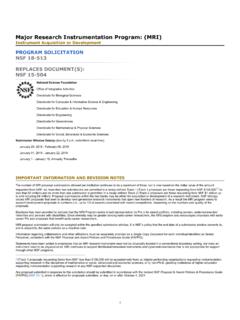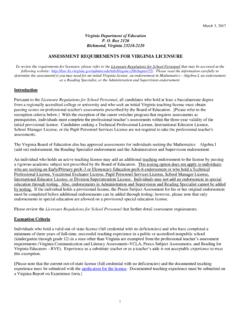Transcription of Growing upland rice: a production handbook
1 Africe rice Center (WARDA). Growing upland rice : a production handbook Oikeh , Nwilene , Agunbiade , Oladimeji O., Ajayi O., Semon M., Tsunematsu H. and H. Samejima About Africa rice Center (WARDA). Africa rice Center (WARDA) is an autonomous intergovernmental research association of African member states and also one of the 15 international agricultural research Centers supported by the Consultative Group on International Agricultural Research (CGIAR). WARDA's mission is to contribute to poverty alleviation and food security in sub-Saharan Africa (SSA) through research, development and partnership activities aimed at increasing WKH SURGXFWLYLW\ DQG SUR WDELOLW\ RI WKH ULFH VHFWRU LQ ZD\V WKDW HQVXUH WKH VXVWDLQDELOLW\ RI WKH.
2 Farming environment. WARDA hosts the African rice Initiative (ARI), the rice Research and Development Network for West and Central Africa (ROCARIZ), the International Network for Genetic Evaluation of rice in Africa (INGER-Africa) and the Inland Valley consortium (IVC). It also supports the Coordination Unit of the Eastern and Central African rice Research Network (ECARRN), based in Tanzania. WARDA has its headquarters in Cotonou, Benin and regional research stations near Saint- Louis, Senegal and at the International Institute for Tropical Agriculture (IITA) in Ibadan, Nigeria. WARDA's main research center is in C te d'Ivoire but most scientists and researchers are temporarily located in Cotonou.
3 For more information, visit Africa rice Center (WARDA) Headquarters 01 BP 2031. Cotonou, Benin Tel: (229) Fax: (229) Email: WARDA Nigeria Station WARDA Sahel Station Tanzania Station WARDA ADRAO, BP 96, St-Louis, c/o Mikocheni Agricultural c/o International Institute of Senegal Research Institute Tropical Agriculture (IITA) PO Box 6226. Oyo Road, PMB 5320 Dar es Salaam Ibadan Tanzania Nigeria Tel: (234-2) 241 2626 Tel: (221) 962 6493 Tel: (255) 222775568. Fax: (234-2) 241 2221 (221) 962 6441 Fax: (255) 222700092. Fax: (221) 962 6491. E-mail: E-mail: Email: Contents Preface 2. Introduction 3. The rice plant 4. Share of upland rice areas in Nigeria 5.
4 Major upland production constraints 5. Choice of land 6. Land preparation 6. Recommended upland varieties 7. Choice of seed 7. Sources to contact for good quality seed 8. Seed viability testing and seed requirement 8. Seed treatment 9. Sowing time 10. Sowing methods 10. Spacing and seeding rate 10. Thinning seedlings 11. Fertilizers 11. Fertilizer application 12. Fertilizers recommendation 13. Fertilizer calculations 19. Legume rice rotation systems 20. Weed control 22. Pests and disease control 24. Bird control 27. Harvesting 28. Threshing 29. Winnowing 30. Drying 30. Parboiling 31. Milling 32. Storage conditions 33. Control of storage pests 33.
5 Further reading 34. Annex 1 35. Annex 2 36. Pesticide safety 37. Growing upland rice : a production handbook Africa rice Center (WARDA) 1. Preface upland rice production accounts for 20% of the total rice produced in Nigeria. With the development of New rice for Africa (NERICA) for upland production systems, a number of farmers have shown interest in Growing upland rice . Unfortunately, these farmers do not have a ready source of information on upland rice production . This handbook will provide a reference source for research and training QH TKEG TGUGCTEJGTU GZVGPUKQP QH EGTU /5E CPF 2J& UVWFGPVU CPF . farmers. It will also be a valuable document for research technicians and undergraduate agricultural students in colleges of agriculture and universities seeking practical information on upland rice production .
6 The handbook is based on experiences accumulated at the Africa rice Center (WARDA) in Nigeria and elsewhere. The handbook covers every aspect of upland rice production from land preparation and seed to the plate. Support for the production of this handbook has come from the African rice Initiative with funding from African Development Bank. 9#4&# RGTOKVU TGRTQFWEVKQP QH VJKU JCPFDQQM HQT PQP RTQ V RWTRQUGU . 2 Growing upland rice : a production handbook Africa rice Center (WARDA). Introduction Nigeria is the largest producer of rice in the West Africa sub-region. Today, rice is no longer a luxury food to millions of Nigerians but has become the cereal that constitutes a major source of calories for the rural and urban poor with demand Growing at an annual rate of 5%.
7 Urbanization, changes in employment patterns, income levels, and rapid RQRWNCVKQP ITQYVJ JCXG UKIPK ECPVN[ EQPVTKDWVGF VQ YKFGPKPI VJG ICR . between supply and demand for rice in Nigeria. Nigeria has the potential and suitable agro-ecologies ( upland , rainfed lowland, irrigated lowland, deep water and mangrove swamp) to attain UGNH UWH EKGPE[ KP TKEG RTQFWEVKQP 6JG RQVGPVKCN NCPF CTGC HQT TKEG . production in Nigeria is estimated at to million hectares. But only about million hectares of this land is presently being cropped to rice . The rainfed upland rice ecology represents 25% of the million hectares. With the recent breakthrough in the development of the New rice for Africa (NERICA) for upland production systems and the high demand for rice , farmers' interest in Growing upland rice has increased.]]
8 Farmers CPF GZVGPUKQP QH EGTU JCXG TGRGCVGFN[ FGOCPFGF KPHQTOCVKQP QP JQY VQ . grow/produce upland rice including the NERICA. This handbook is an attempt to meet this demand with the hope that it will positively impact upland rice production and productivity in Nigeria. Growing upland rice : a production handbook Africa rice Center (WARDA) 3. The rice plant A rice plant with four tillers Flag leaf Panicle Leaf Tiller Stem Roots A tiller is a shoot different from the main stem and has roots and leaves. It may or may not have a panicle. 4 Growing upland rice : a production handbook Africa rice Center (WARDA). Table 1. Share of upland rice areas in Nigeria Estimated Share Average production Major states share of of rice yield systems covered national rice production (tonne/ha).]
9 Area (%) (%). Benue, Delta, Edo, Ekiti, Kaduna, Kebbi, Rainfed Kogi, Kwara, upland Niger, Ogun, 30 20. Ondo, Osun, Oyo and Sokoto States Major upland production constraints Biotic Weeds Insect pests - Stem borers - Termites Diseases - Blast - Brown spot Nematodes Vertebrate pests - Birds, - Rodents Abiotic Drought .QY UQKN HGTVKNKV[ . 0 2 - <P CPF (G FG EKGPEKGU . Soil acidity Soil erosion Growing upland rice : a production handbook Africa rice Center (WARDA) 5. Choice of land Select your site in an ecological zone with at least 14 20 mm of XG FC[ TCKPHCNN FWTKPI VJG ITQYKPI E[ENG . Choose fertile land with good drainage and good water retention capacity (contains some clay and/or organic matter, loamy soil).)]]]
10 If you have to grow rice for more than one consecutive year on the same piece of land, seek the advice of the Soil Survey and Testing Service of the Institute of Agricultural Research and Training (IAR&T) or any other reputable soil-testing unit. Land preparation 1. Mechanization (forest area). For newly cleared areas, stump big trees before the rains, preferably from November to February, and remove all stumps, roots and trees before ploughing. 2 NQY QPEG CPF FKUE JCTTQY VYKEG YKVJ VJG TUV TCKPU . HTQO NCVG . February to early March in the south) to make a good tilth if land KU CV . Plow and disc harrow once if the land is sloppy.
















